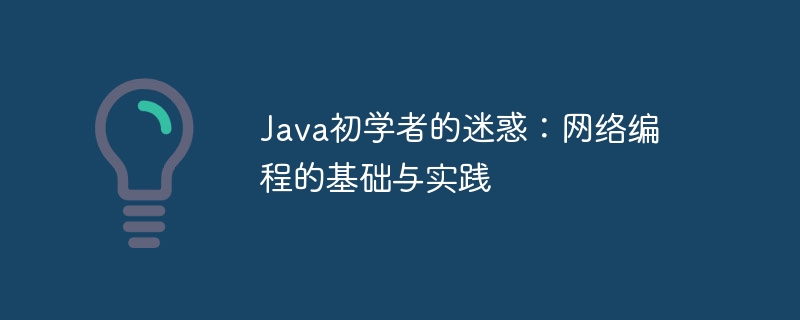Home >Java >javaTutorial >Confusion for Java Beginners: Fundamentals and Practice of Network Programming
Confusion for Java Beginners: Fundamentals and Practice of Network Programming
- WBOYWBOYWBOYWBOYWBOYWBOYWBOYWBOYWBOYWBOYWBOYWBOYWBOriginal
- 2024-05-07 14:21:02799browse
Network programming is an important skill in Java development and involves network communication. Mastering it requires understanding the TCP/IP protocol (TCP provides reliable connections, UDP provides fast connectionless data transfer, and IP is responsible for routing), and programming with sockets (server sockets listen for connections, client sockets serve connections and exchange data). These concepts can be understood in depth through practical exercises such as setting up a client-server chat.

Confusion for Java Beginners: The Basics and Practice of Network Programming
Network programming is an important skill in Java development. It allows applications to communicate with other devices on the network. Network programming can be confusing for beginners, but by understanding some basic concepts and doing it hands-on, you can master its essence.
TCP/IP Protocol
TCP/IP (Transmission Control Protocol/Internet Protocol) is the foundation of network programming. It is a suite of protocols that defines how data is transmitted over a network. The main protocols include:
- TCP: Provides a reliable connection for data transmission.
- UDP: Provides fast, connectionless data transmission.
- IP: Responsible for routing data packets to their destination.
Socket Programming
Sockets are the endpoints through which applications communicate with the network. In Java, you can use the Socket class to create sockets. There are two types of sockets:
- Server socket: listens for connection requests from clients.
- Client Socket: Connect to the server socket and send or receive data.
Practical Example: Building a Simple Client-Server Chat
Let’s apply these concepts through a simple chat program:
Server-side code:
import java.io.*;
import java.net.*;
public class Server {
public static void main(String[] args) {
try {
ServerSocket serverSocket = new ServerSocket(5000);
while (true) {
Socket clientSocket = serverSocket.accept();
BufferedReader reader = new BufferedReader(new InputStreamReader(clientSocket.getInputStream()));
String message = reader.readLine();
System.out.println("Received message from client: " + message);
PrintWriter writer = new PrintWriter(clientSocket.getOutputStream(), true);
writer.println("Hi from the server!");
}
} catch (IOException e) {
e.printStackTrace();
}
}
}Client-side code:
import java.io.*;
import java.net.*;
public class Client {
public static void main(String[] args) {
try {
Socket clientSocket = new Socket("localhost", 5000);
PrintWriter writer = new PrintWriter(clientSocket.getOutputStream(), true);
writer.println("Hello from the client!");
BufferedReader reader = new BufferedReader(new InputStreamReader(clientSocket.getInputStream()));
String message = reader.readLine();
System.out.println("Received message from server: " + message);
} catch (IOException e) {
e.printStackTrace();
}
}
}Running steps:
- Start the server-side program.
- Start the client program.
- Type a message in the client prompt and press Enter to send.
- The server will receive and print the client's message.
- The server replies with a message, and the client will receive and print it.
Conclusion
With this simple example, you have built a basic client-server network application. Understanding these basic concepts and practicing them will help you master Java network programming and prepare you for more complex network application development.
The above is the detailed content of Confusion for Java Beginners: Fundamentals and Practice of Network Programming. For more information, please follow other related articles on the PHP Chinese website!

